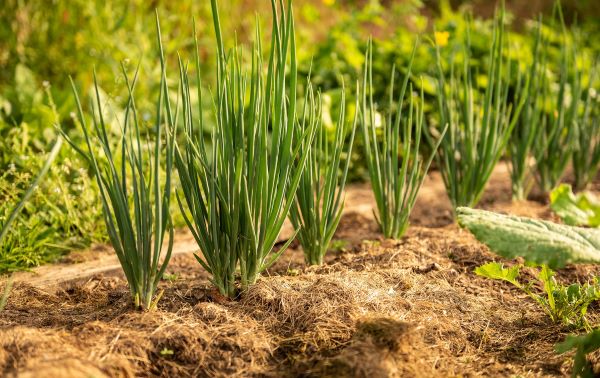Smart Gardening: Converting to No-Till for Home Gardeners

I often hear from vegetable or flower gardeners who are unhappy with their soil quality. They routinely incorporate organic matter in the soil each fall, but are still disappointed with their heavy soil. Why aren’t they developing beautiful crumbly dark brown soil that’s easy to plant and great for vegetable root crops?
Routinely tilling your garden soil each fall and spring could be the culprit.
Microbes, Humus and Soil Aggregation
USDA Natural Resource Conservation Service encourages building soil health and protecting soil organisms, through
- keeping the soil covered as much as possible
- disturbing soil as little as possible
- keeping plants growing throughout the year to feed soil, and
- diversifying plant material through crop rotation.
Soil is a combination of non-living materials - sand, silt, and clay particles - along with organic matter and living organisms. The largest living soil organisms include earthworms, insects and nematodes, the smallest are bacteria and fungi. But there are many, many soil organisms in between!
Organic matter comes from the decomposing remains of plant and animal life and is a food source for these soil organisms, releasing nutrients as it breaks down into humus. The amount of organic matter in soil varies depending on the kinds of crops grown, whether plant residue is removed or incorporated into the soil, the frequency of tillage, and the wetness or drainage of the soil.
Humus is decomposed organic matter that has reached a stable stage and will not decompose any further without a change in temperature, pressure or heat. It’s very important to healthy soil because it increases populations of soil organisms by improving water-holding capacity and water percolation, and reduces soil erosion and nutrient leaching. Through their normal life processes, soil organisms create substances that act as glue, binding together organic matter, humus, silt, clay and sand particles creating soil aggregates and improving soil structure.
Benefits of No-Till Gardening
Tilling physically disrupts or breaks down soil aggregates, those tiny clumps of silt, clay, sand and humus. These tiny clumps are important because they create large and small pore spaces in the soil, which are used as pathways for water, oxygen and plant roots to penetrate the soil.
Reducing or eliminating tilling in your garden provides the following benefits.
- Slower decomposition of organic matter, resulting in increased organic matter levels
- Increased soil organism populations and activity
- Retention of current soil aggregates and increased formation of new soil aggregates
- Improved water percolation into soil and water drainage
- Improved soil aeration
- Improved crop root development
- Increased resistance to wind and water soil erosion
Converting to No-Till Gardening
How can you convert existing gardens to no-till? Start this fall or winter; collect all the available organic matter you can find, such as tree leaves, pine needles, sawdust, wood chips, bark, corn cobs, corn stalks, grass clippings or straw. Newspaper and cardboard are useful too. Manure can also be used, just make sure to use composted manure in vegetable gardens.
Using your organic materials, create a mulch layer 8 to 10-inches deep over the soil. When using newspaper or cardboard, start with several layers and top them with 2 to 4-inches of leaves, grass clippings, etc. This will hold the paper and cardboard in place as they degrade.
Design your garden with planting beds narrow enough to plant, weed and harvest without walking in them, which would increase soil compaction. 4-foot wide planting beds work well. Walking paths can be mulched or planted with grass or another ground cover.
Guess what? You’re done! The organic matter will begin to break down over winter. Earthworms and other soil organisms will incorporate the organic matter into the underlying soil. Over time your soil organic matter levels will increase, along with increasing numbers of soil microbes and improved soil aggregation imparting all the benefits discussed above.
When you’re ready to plant in spring, simply push aside the mulch layer where you want to place your seeds or transplants. Use a hoe to create a planting furrow or hand-dig holes for individual transplants. Once the plants are up and growing, pull the mulch back in place or reapply fresh mulch around the base of the plants. This will prevent rain splash of soil and plant pathogens onto the lower leaves (which is the most common method of disease introduction) and conserve soil moisture.
At the end of the growing season, incorporate the dead vegetation into the mulch layer. Or, if you prefer, compost it first, then spread the compost over your garden. Replenish the mulch layer over planting beds in fall and winter as needed to maintain 8 to 10-inch layer.
Gain Mastering Over Weeds
One final benefit of no-till gardening - reducing weed problems. Tilling brings fresh weed seed to the soil surface each year, so combining good weed management with no-till practices will eventually reduce the amount of weed seed in the upper few inches of soil. Plus, the thick mulch layers used to create your beds reduces light penetration to the soil surface and further reduces weed seed germination.
This article was reviewed by Nicole Stoner
Sign up for updates from UNL Water
